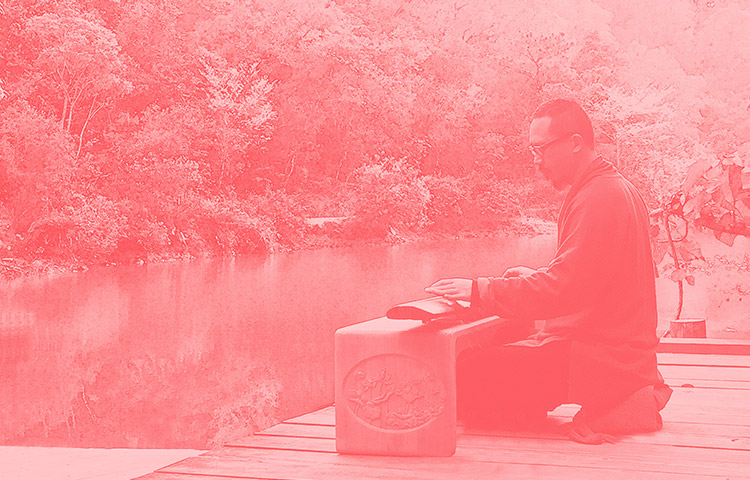
Shen piji
Artist
Born of an intellectual family in Zhao’an, home of painting and calligraphy in southern Fujian, in 1997, inheriting the learning of Chinese traditional calligraphy and painting and folk music since childhood. In 1985, began learning guitar; in 1988, entered Xiamen Academy of Arts and Design, Fujian University, as a major in modern lacquer art; in 1993, began to work and live in Shenzhen, where he obtained experience as a space designer for entertainment venues, and he’s also become one of the representative figures in avant-garde music and contemporary art in Shenzhen since the early 1990s. In 1995, joined the Shenzhen band “Black Hole”; in 1997, reformed “The Sunflower”, an underground rock band in Shenzhen, with himself being the lead singer and lead guitarist, and helped make the band an active role in Chinese underground rock world and punk music area, including national tours of important cities in China, which has all been collected into Encyclopedia of China Rock & Roll, a record of rock and roll in China published in 2006.
After 2000, Shenpiji diverted his preference to the site of experimental sound and improvisational music, and began paying attention to pure sound experimentation and the creation and practice of avant-garde visual art, like Life · Pressure Sound Experiment Site Series (Shenzhen; 2003, 2007, 2009), the opening ceremonial site of Shenzhen Biennale of Urbanism \ Architecture and Every Day, a work reflecting the relationship between sound and architecture (Shenzhen, 2007), “Leisure Alone · Free Beat” Solo Experimental Concert (Neo Sound 6 ISSUE: SHEN Piji) (Shenzhen, 2010), Jazz Improvise Meeting Festival (Shenzhen, 2015), CHOP Festival: Polish Experimental Music in China (Shenzhen; 2013, 2014), International Poetry Nights in Hong Kong (Hong Kong, 2015), “Ear Cleaning” Experimental Sound Site (Shenzhen, 2016), and the opening ceremonies of some art exhibitions with experimental sound performances in recent years. After 2010, founded Wutong Guqin Society at Mount Wutong, Shenzhen, became the 13th-generation successor of the Guangling school of Guqin, and conducted performances and made attempts in such two aspects as the continuation of traditional Guqin and the experimentality of contemporary Guqin.
Shenpiji’s creation involves forms such as audio, installation, video, performance, painting and poetry, and has long been presented in the artistic fashion of new media focused on the interaction of audio, visual and performance. For example: The 5th International Ink Art Biennale of Shenzhen (Shenzhen, 2007), “ Shenpiji Is Here” Solo Exhibition (Shenzhen, 2009), “ Shenpiji’s Lines” Solo Exhibition (Hong Kong, 2014), “Where Is Shenpiji” Solo Exhibition (Shenzhen, 2016), “Faced to Hylarana Daunchina” one-year performance (Mount Wutong, Shenzhen, 2015). With his motives for creation closely linked to personal life, his cross-boundary works reflect much of his attention to and feeling of the rapid development and change of modern cities and have to a certain extent made an artistic recreation out of his thinking about and understanding of the universality of everything in nature.
In recent years, Shenpiji has curated a number of art shows for performance art and sound art, such as Xiamen Time Gap: The 1st Xiamen International Live Art Festival (The Art Department of Xiamen University, 2014), Speed Shifting: Misthaus Experiment · Shenzhen Performance Project (Shenzhen, 2014), The 10th “Guyu Action” Performance Art Festival (Shenzhen, 2016), iD TOWN Sound Live Art Festival (Shenzhen, 2016), and participated in the on-site creation of Embodied Action, Enacted Bodies: Hong Kong International Performance Art Festival (Hong Kong; 2014, 2015), Inward Gazes: Documentaries of Chinese Performance Art (Macao, 2014), “Guyu Action” Contemporary Performance Art Festival (Xi’an, 2014).
沈丕基,1971年出生于福建闽南书画之乡诏安的书香门第,自幼承习中国传统书画与民间音乐。1985年开始学习吉他,1988年进入福州大学厦门工艺美术学院主修现代漆画,1993年工作生活于深圳,曾为娱乐场所的空间设计师,同时也是深圳九十年代至今先锋音乐和当代艺术的代表人物之一。1995年参加了深圳“黑洞”乐队,1997年组建“向日葵”深圳地下摇滚乐队,任主唱与主音吉他,活跃于当时中国的地下摇滚界与朋克音乐领域以及举行了国内重要城市的全国巡演,被收录到2006年出版的记录中国摇滚的《中国摇滚手册》中。
2000年之后,沈丕基偏向于实验声音与即兴音乐的现场,转入对纯粹声音实验以至先锋视觉艺术的创作与实践,如:《生活·压力》声音实验现场系列(2003、2007、2009·深圳)、深圳建筑双年展的开幕现场以及声音与建筑关系的作品《每天》(2007·深圳)、“独闲·散拍”个人实验音乐会(2010·深圳)、德-中爵士即兴音乐节(2015·深圳)、波兰CHOP国际音乐节(2013、2014·深圳)、香港国际诗歌节(2015·香港)、“采耳”实验声音现场(2016·深圳)等,以及近年来的一些艺术展的实验声音表演开幕式。2010年之后,在深圳梧桐山成立了深圳梧桐琴社,成为古琴广陵派第十三代传人,并对传统古琴的传承与当代古琴实验性做出了两个方面的演奏与尝试。
沈丕基作品涉及声音、装置、影像、行为、绘画、诗歌等形式,并长期将声音、视觉与行动的交互为介质切入以新媒体艺术方式来呈现。如:第五届深圳水墨双年展(2007·深圳)、“沈丕基在这里”个展(2009·深圳)、“沈丕基的线”个展(2014·香港)、“沈丕基在哪里”个展(2016·深圳)、“对蛙行动”一年行为(2015·深圳梧桐山),创作动机与个人生活联系紧密,跨界性作品多呈现为对现代城市的快速发展变化的关注与感受,并对自然万物通界的思考领悟做出了一定艺术再现。
沈丕基近年来策划了一些行为艺术与声音艺术的艺术展,如:“厦门时差”首届厦门国际行为艺术节(2014·厦门大学美术学院)、“前方变速”国际行为艺术计划(2014·深圳)、第十届“谷雨行动”行为艺术节(2016·深圳)、首届艺象声音现场艺术节(2016·深圳),并参加了“身体力行”香港国际行为艺术节(2014、2015·香港)、“以身观身”澳门国际行为艺术节(2014·澳门)、“谷雨行动”国际行为艺术节(2014·西安)的现场创作。